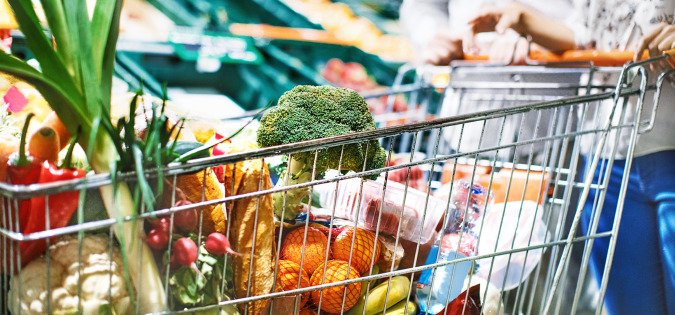We’re all aware of the importance of healthy eating to our overall health, energy, and wellbeing. If you find there are times you start food shopping with the best intentions and wind up making poor choices, you’re certainly not alone. Research has shown that unplanned purchases account for up to 60% of all purchases (Inman and Winer, 1998, Mattila and Wirtz, 2008) and that impulse buys can account for anywhere from 40% to 80% of purchases.
However, there are strategies you can use when shopping for food. These will help you avoid pitfalls and stay focused enough to make healthier choices to support your health and fitness goals.

Two fundamental prINCIPLES when buying food in a food sTORE
When you’re buying food, it’s important to remember two key principles to healthier choices:
- Avoid shiny objects.
- Keep things simple.
Shiny objects are those extra bright, colourful packages designed to catch our attention as we walk by. These are usually the unhealthy items designed to sway us toward the naughty path and away from our healthy eating intentions. Avoid them like the plague.
Keeping things simple means choosing items as close as possible to their natural state. This means avoiding food items with a long list of tongue-twisting ingredient. More on that later.
Here are 5 strategies to help make better food choices when venturing into your local food store.

1. Don’t shop hungry
Shopping on an empty stomach is a sure-fire way to choosing unhealthy food items.
When you’re hungry, all you can think about is feeding the calories you’re currently missing.
The reason for this is often low blood sugar. When your blood sugar drops you usually crave a quick sugar fix to prop it back up again.

So, before you go food shopping, eat a meal or at least a healthy snack. Go for something substantial that will fill you up and keep those blood sugar levels balanced. This way you can easily (and smugly) pass by those unhealthy items you’re desperately trying to avoid.
2. Shop around the outer aisles of the supermarket
Most food stores follow a similar floor layout. Quite often the further into the centre you go the unhealthier things become.
Stay on the outer aisles and you’ll find fruit, vegetables, fresh meats, fish. Generally, the unprocessed options represent healthy eating. Go further in, and you’re into the realm of the shiny packaged, highly processed items you’d prefer to stay away from.
By limiting your path to the outer edges of the food store, you’re more likely to stay on the straight and narrow when it comes to making better food choices.

3. If there are ingredients in a product that you can’t pronounce, don’t buy it
An important aspect of healthy eating is staying away from preservatives and unnatural ingredients (i.e., made in a laboratory instead of occurring naturally).
The reason for this is when you consume something unnatural, your body usually doesn’t know how to fully digest it. So instead of digesting these unhealthy items, they get stored as fat.
You’ve probably guessed how to identify these unnatural items. They’re usually 2-3 syllables and require a few tries to pronounce correctly.
So, when you look at the ingredients of what you’re buying (and if you aren’t doing this, it’s a great habit to start), if you start seeing words you can’t easily pronounce, give it a miss.

4. If there are more than 3 ingredients in a product don’t buy it
By shopping for foods with minimal ingredients, you’re leaning toward those items that are the less processed.
When food is highly processed it loses nutritional value. These highly processed foods are quickly digested. Quick digestion means the digested food is converted to sugar in the bloodstream quicker, meaning a more rapid secretion of the hormone insulin. (Insulin is how your body balances out blood sugar to return your body to a state of balance or homeostasis).

If you continue to eat processed foods, your body will continue to quickly release more and more insulin. Over time, your body will become immune to the balancing effects of insulin. When this happens (also referred to as insulin resistance), you’ll be on your way to Type II Diabetes. This is why processed foods need to be avoided.
An example of processed versus unprocessed food is white rice versus brown rice. If you eat white rice, because the nutritional value has been mostly removed during processing, your body will digest it faster.
However, if you choose a brown rice, your body takes more time to digest it because the nutritional value hasn’t been stripped away. As such, the conversion to sugar in your blood will be slower. This means the secretion of insulin will also be slower.
A slow, steady release of insulin means a more natural and regulated response to blood sugar increases. By choosing unprocessed foods, your body will respond as it’s designed to and your health will be maintained as a result.
5. Do your food shopping online
Doing your food shopping online can give you more freedom in the times you choose to do it. This may make it easier for you to choose times to shop when you’re not hungry and as a result make better choices. It can also save you some time too, cutting out your commute to the store.

Shopping online can help lower impulse buys and tempting special offers that may not be the best or your intended choices. Whilst shopping online we tend to search directly for healthier items already on our list (using the search function where we enter the exact product item), rather than drifting up and down aisles in the food store and discovering or being tempted by items we want to avoid.
Ever felt a little frustrated in your local supermarket and found yourself pacing up and down all the aisles for an item you’ve bought the past few weeks from the same spot? Moving items around the store is a ploy food stores use to increase your spend with impulse buys you wouldn’t usually discover. Shopping online can help you to avoid these ploys. The supermarkets adopt these tactics online too but you may find them less effective than in store.
When shopping online it’s also easier to take a quick scan through your online basket before you hit the checkout. Seeing the items laid out neatly makes it easier to spot (and remove) those items you’re trying to avoid that have slipped in. This can be more difficult to do in store when those pesky shiny wrapped, processed foods are wedged at the bottom of your trolley, hiding beneath the fresh fruit and vegetables.
Try these five strategies to make your next outing to your local food store healthier.
The Fit to Last Framework
The Fit to Last Framework is our 12-month nutrition and lifestyle coaching programme based on a series of micro-habits. If you’d like guidance, support and accountability in creating small wins leading to big changes, get in touch.
ABOUT JAMES STARING

 James Staring is a personal trainer based in Clapham, London. His methods have featured in publications such as Your Fitness, Hello, Healthy, Daily Mail, Closer, and many more. After giving up smoking and entering the fitness industry in 2009, James has focused on his passion to help others transform their health and fitness. However, James is convinced most people struggle so much more than they need to in an effort to improve their fitness. Through his company, Fit to Last, James has helped hundreds of men and women make small adjustments in their daily habits to transform their fitness and to love how they look and feel.
James Staring is a personal trainer based in Clapham, London. His methods have featured in publications such as Your Fitness, Hello, Healthy, Daily Mail, Closer, and many more. After giving up smoking and entering the fitness industry in 2009, James has focused on his passion to help others transform their health and fitness. However, James is convinced most people struggle so much more than they need to in an effort to improve their fitness. Through his company, Fit to Last, James has helped hundreds of men and women make small adjustments in their daily habits to transform their fitness and to love how they look and feel.

